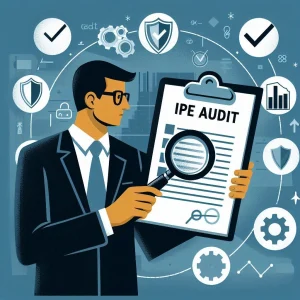In today’s rapidly evolving digital landscape, the intersection of cybersecurity risks and enterprise risk management (ERM) audits has become increasingly significant. Enterprise risk management internal audit practices are now crucial as organizations face a growing array of cyber threats, highlighting the need for robust ERM strategies that incorporate these risks.
Definition of Enterprise Risk Management (ERM) and Internal Audit
Enterprise Risk Management (ERM) is a comprehensive framework that organizations use to identify, assess, manage, and monitor risks that could potentially impact their objectives. It encompasses a wide range of risks, including operational, financial, strategic, and compliance risks, with the goal of enhancing decision-making and ensuring the organization’s resilience against uncertainties.
Internal audit, on the other hand, serves as an independent assurance function that evaluates the effectiveness of an organization’s risk management processes, internal controls, and governance. Internal auditors play a crucial role in assessing the adequacy of ERM frameworks and ensuring that risks, particularly those related to cybersecurity, are appropriately managed and mitigated.
Overview of the Rising Cybersecurity Threats in Today’s Digital Landscape
The digital landscape is fraught with escalating cybersecurity threats, including data breaches, ransomware attacks, and phishing schemes. These threats not only jeopardize sensitive information but also pose significant risks to an organization’s reputation, financial stability, and operational continuity. As cybercriminals become more sophisticated, the potential impact of these threats on business operations has grown, making it essential for organizations to prioritize cybersecurity within their ERM frameworks.
Importance of Addressing Cybersecurity Risks in ERM Strategies
Incorporating cybersecurity risks into ERM strategies is critical for several reasons:
- Holistic Risk Assessment: By recognizing cybersecurity as a key component of overall risk management, organizations can conduct more comprehensive risk assessments that account for the potential impacts of cyber threats on business objectives [2][3].
- Proactive Mitigation: Addressing cybersecurity risks allows organizations to implement proactive measures to mitigate potential breaches, thereby reducing the likelihood and impact of cyber incidents [10].
- Regulatory Compliance: With increasing regulatory scrutiny surrounding data protection and cybersecurity, organizations must ensure that their ERM strategies align with legal requirements, thereby avoiding potential penalties and reputational damage [6].
- Enhanced Resilience: A well-integrated approach to ERM that includes cybersecurity considerations fosters organizational resilience, enabling businesses to respond effectively to incidents and recover swiftly from disruptions [5][9].
As the landscape of cybersecurity threats continues to evolve, internal auditors and risk managers must adapt their ERM strategies to address these challenges effectively. This introduction sets the stage for a deeper exploration of how rising cybersecurity threats are shaping ERM strategies and the critical role of internal audits in this process.
Understanding Cybersecurity Risks
In the realm of Enterprise Risk Management (ERM), the increasing prevalence of cybersecurity threats has become a critical concern for internal auditors, CIOs, and risk managers. As organizations navigate this complex landscape, it is essential to understand the various types of cybersecurity risks they face, as well as the implications these risks have on ERM strategies.
Common Cybersecurity Threats
Organizations encounter a variety of cybersecurity threats that can compromise their data integrity and operational continuity. Some of the most prevalent threats include:
- Malware: Malicious software designed to disrupt, damage, or gain unauthorized access to computer systems. This category includes viruses, worms, and Trojans, which can lead to significant data breaches and operational disruptions.
- Phishing: A technique used by cybercriminals to deceive individuals into providing sensitive information, such as usernames and passwords. Phishing attacks often occur through deceptive emails or websites, making them a common threat in the digital landscape.
- Ransomware: A type of malware that encrypts a victim’s files, rendering them inaccessible until a ransom is paid. Ransomware attacks have surged in recent years, targeting organizations across various sectors and causing substantial financial losses and reputational damage.
Statistics on Cybersecurity Incidents
The impact of cybersecurity incidents is profound, with statistics highlighting the urgency of addressing these threats:
- According to recent studies, over 60% of small and medium-sized businesses that experience a cyber attack go out of business within six months. This statistic underscores the critical need for robust cybersecurity measures within ERM frameworks.
- The average cost of a data breach has reached approximately $4.24 million, reflecting not only the immediate financial impact but also the long-term consequences on customer trust and brand reputation.
Emerging Cybersecurity Threats and Trends
As technology evolves, so do the tactics employed by cybercriminals. Internal auditors and risk managers must stay informed about emerging threats to effectively shape their ERM strategies:
- IoT Vulnerabilities: The proliferation of Internet of Things (IoT) devices has introduced new vulnerabilities, as many of these devices lack adequate security measures. Cybercriminals can exploit these weaknesses to gain access to larger networks, posing significant risks to organizational security.
- AI-Driven Attacks: The rise of artificial intelligence (AI) is also influencing the cybersecurity landscape. Cybercriminals are increasingly using AI to automate attacks, making them more sophisticated and harder to detect. This trend necessitates a reevaluation of existing ERM strategies to incorporate advanced threat detection and response mechanisms.
Understanding the landscape of cybersecurity risks is essential for internal auditors and risk managers as they develop and implement effective ERM strategies. By recognizing common threats, analyzing the impact of incidents, and staying abreast of emerging trends, organizations can better prepare for and mitigate the risks associated with cybersecurity. This proactive approach not only safeguards assets but also enhances overall organizational resilience in the face of evolving threats.
The Role of Internal Audit in ERM
In the evolving landscape of enterprise risk management (ERM), internal auditors play a pivotal role in ensuring that organizations effectively navigate the complexities of risk, particularly in the realm of cybersecurity. As threats continue to rise, the integration of internal audit functions within the ERM framework becomes increasingly critical. Here’s an overview of how internal auditors contribute to the effectiveness of ERM processes.
Overview of the Internal Audit Function within the ERM Framework
Internal audit serves as an essential component of the ERM framework, providing a structured and consistent approach to identifying, assessing, and managing risks across the organization. This function is not limited to traditional assurance services; it encompasses a broader scope that includes evaluating risk management processes and reporting on key risks that could impact the organization’s objectives [1]. By embedding themselves within the ERM framework, internal auditors help ensure that risk management strategies are not only robust but also aligned with the organization’s overall goals.
Importance of Internal Auditors in Assessing Risk Management Strategies
The role of internal auditors extends beyond mere compliance checks; they are integral in assessing the effectiveness of risk management strategies. With their unique position, internal auditors can provide valuable insights into potential weaknesses and areas for improvement within the risk management processes [8]. They evaluate the rigor and transparency of these strategies, ensuring that they are capable of addressing both existing and emerging risks, particularly those related to cybersecurity [5]. This assessment is crucial as organizations face increasing pressure to enhance their risk management capabilities in light of evolving cyber threats.
Facilitating Communication Between Risk Management and IT Security Teams
One of the key contributions of internal auditors is their ability to facilitate communication between risk management and IT security teams. Given the interconnected nature of risks, particularly in cybersecurity, it is essential for these teams to collaborate effectively. Internal auditors can bridge the gap by ensuring that both teams are aligned in their understanding of risks and the strategies in place to mitigate them. This collaboration not only enhances the organization’s overall risk posture but also fosters a culture of shared responsibility for risk management across departments.
The impact of rising cybersecurity threats on ERM strategies cannot be overstated. Internal auditors are uniquely positioned to enhance the effectiveness of ERM processes by providing critical assessments, facilitating communication, and ensuring that organizations are prepared to tackle the challenges posed by an increasingly complex risk environment. Their role is vital in shaping a proactive approach to risk management that safeguards the organization’s assets and reputation.
Integrating Cybersecurity into ERM Frameworks
As cybersecurity threats continue to evolve and escalate, their impact on enterprise risk management (ERM) audits has become increasingly significant. Internal auditors, CIOs, and risk managers must adapt their strategies to effectively incorporate these risks into their existing ERM frameworks. Here are some key strategies and best practices for integrating cybersecurity risks into ERM processes.
Steps to Assess and Identify Cybersecurity Risks within the ERM Process
- Conduct a Cyber Risk Assessment: The first step in integrating cybersecurity into ERM is to perform a comprehensive cyber risk assessment. This involves identifying potential vulnerabilities, threats, and the potential impact of cyber incidents on the organization’s objectives. Internal auditors should distill the findings into a concise summary to facilitate understanding and action.
- Utilize Risk Registers: Implementing risk registers can help in tracking identified cybersecurity risks alongside other enterprise risks. This allows for a more holistic view of the organization’s risk landscape and ensures that cybersecurity is not treated as a siloed issue [8].
- Engage Stakeholders Across the Organization: Collaboration among various departments is crucial. Leaders across different lines of defense must coordinate efforts to identify and respond to changing risk profiles as new technologies and threats emerge [3]. This cross-functional approach enhances the effectiveness of the ERM framework.
Best Practices for Integrating Cybersecurity Assessments into Risk Assessments
- Dynamic Risk Monitoring: Establish dynamic risk monitoring and reporting systems that adapt to the real-time risk environment. This ensures that cybersecurity risks are continuously evaluated and addressed as they evolve [5].
- Incorporate Cybersecurity Metrics: Integrate specific cybersecurity metrics into the overall risk assessment process. This can include tracking incidents, response times, and recovery efforts, which provide valuable insights into the organization’s cybersecurity posture [6].
- Regular Training and Awareness Programs: Conduct regular training sessions for employees to raise awareness about cybersecurity risks and best practices. This proactive approach helps in building a culture of security within the organization, which is essential for effective risk management [7].
Importance of a Proactive Risk Management Approach to Cybersecurity
Adopting a proactive risk management approach is vital in today’s threat landscape. Organizations must not only react to incidents but also anticipate potential risks and implement preventive measures. This includes:
- Continuous Improvement of Security Protocols: Regularly updating and improving security protocols based on the latest threat intelligence and industry best practices is essential for staying ahead of cyber threats [2].
- Integration of Cybersecurity into Business Strategy: Cybersecurity should be viewed as a critical component of the overall business strategy. By aligning cybersecurity initiatives with business objectives, organizations can ensure that they are adequately prepared to manage risks while pursuing their goals [1].
Integrating cybersecurity into ERM frameworks is not just a necessity but a strategic imperative for organizations. By following these steps and best practices, internal auditors and risk managers can enhance their risk management strategies, ensuring that they are well-equipped to address the challenges posed by rising cybersecurity threats.
Challenges Internal Auditors Face
As organizations increasingly recognize the significance of cybersecurity within their enterprise risk management (ERM) frameworks, internal auditors encounter a range of challenges that complicate their efforts to effectively address these risks. Here are some of the key challenges faced by internal auditors in the context of cybersecurity and ERM audits:
- Limited Resources and Expertise in Cybersecurity: Many internal audit teams struggle with a lack of specialized knowledge and resources dedicated to cybersecurity. As the demand for skilled auditors who understand the complexities of cyber risks grows, organizations often find it difficult to recruit and retain professionals with the necessary expertise. This gap can hinder the effectiveness of audits and the ability to provide comprehensive assessments of the organization’s cybersecurity posture [1].
- Keeping Up with Rapidly Evolving Cyber Threats and Compliance Requirements: The landscape of cybersecurity threats is continuously changing, with new vulnerabilities and attack vectors emerging regularly. Internal auditors must stay informed about these developments to assess risks accurately. Additionally, compliance requirements are becoming more stringent, necessitating that auditors not only understand current regulations but also anticipate future changes. This dynamic environment can overwhelm internal audit functions that are already stretched thin [2].
- Balancing the Need for Thorough Audits with Organizational Constraints: Internal auditors often face pressure to deliver results quickly while maintaining a high standard of quality in their audits. This balancing act can be particularly challenging when addressing cybersecurity risks, which require in-depth analysis and a proactive approach. Organizational constraints, such as limited time and budget, can further complicate the ability to conduct thorough audits that adequately address the complexities of cyber risk management.
Internal auditors play a crucial role in the ongoing battle against cybersecurity threats within the framework of enterprise risk management. However, they must navigate significant challenges, including resource limitations, the fast-paced nature of cyber threats, and the need to balance thoroughness with organizational constraints. Addressing these challenges is essential for enhancing the effectiveness of ERM audits and ensuring that organizations are well-prepared to manage cyber risks.
Future Trends in ERM Audits and Cybersecurity
As the landscape of cybersecurity threats continues to evolve, enterprise risk management (ERM) audits are increasingly influenced by these changes. Internal auditors, CIOs, and risk managers must stay ahead of these trends to effectively safeguard their organizations. Here are some key points to consider regarding the future of ERM audits in the context of rising cybersecurity risks:
Predictions on the Evolution of Cybersecurity Threats
- Increasing Complexity of Threats: Cybersecurity threats are becoming more sophisticated, with a notable rise in ransomware attacks, which affected 66% of organizations in 2023. This trend indicates that organizations must prepare for more complex and targeted attacks that can disrupt operations and compromise sensitive data.
- Zero-Day Attacks and Automated Cybercrime: The emergence of zero-day vulnerabilities and automated cybercrime tactics will require organizations to adopt proactive measures in their ERM strategies. This includes integrating advanced threat detection and response capabilities to mitigate risks before they escalate [4].
- Regulatory Compliance and ESG Integration: As regulatory frameworks evolve, organizations will need to ensure that their ERM audits align with compliance requirements, particularly in the realms of cybersecurity and environmental, social, and governance (ESG) factors. This integration will be crucial for maintaining stakeholder trust and meeting regulatory expectations [11].
The Role of Technology in Enhancing ERM Audits
- Artificial Intelligence and Machine Learning: The adoption of AI and machine learning technologies is expected to revolutionize ERM audits. These tools can enhance risk identification, analysis, and management by providing real-time insights and predictive analytics. As AI technology progresses, it will enable auditors to recognize and address cybersecurity risks more effectively [12][13].
- Emerging Tools and Best Practices: Engaging with innovative tools and methodologies will be essential for internal auditors. This includes leveraging data analytics to assess vulnerabilities and implementing automated solutions to streamline audit processes, thereby improving efficiency and accuracy [5].
Importance of Continuous Improvement and Adaptation
- Dynamic Risk Management Frameworks: The future of ERM audits will hinge on the ability to adapt to the rapidly changing cybersecurity landscape. Organizations must develop agile risk management frameworks that can respond to new threats and incorporate lessons learned from past incidents [10].
- Holistic Approach to Risk Management: A comprehensive approach that integrates financial, operational, and strategic risks, alongside emerging cyber threats, will be vital. This holistic perspective will enable organizations to better understand the interconnectedness of risks and enhance their overall resilience [6].
The impact of rising cybersecurity threats on enterprise risk management audits cannot be overstated. By anticipating future trends, leveraging technology, and committing to continuous improvement, internal auditors can play a pivotal role in shaping effective ERM strategies that protect their organizations from evolving cyber risks.
Conclusion
In today’s rapidly evolving digital landscape, the integration of cybersecurity into Enterprise Risk Management (ERM) is not just beneficial; it is essential. As organizations face an increasing number of cyber threats, the implications for internal audits and overall risk management strategies are profound. Here are the key takeaways:
- Importance of Cybersecurity in ERM: Cybersecurity risks are among the most significant threats to organizations, impacting not only data integrity but also business continuity and reputation. Internal auditors must recognize that a breach could have devastating effects, making it crucial to incorporate cybersecurity considerations into the ERM framework. This integration allows for a more comprehensive understanding of potential vulnerabilities and the development of robust mitigation strategies [1][5].
- Enhancing Risk Management Strategies: Internal auditors and Chief Information Officers (CIOs) are urged to enhance their risk management strategies by prioritizing cybersecurity. This involves conducting regular audits to identify security weaknesses and vulnerabilities that could be exploited by cyber threats. By focusing on the most vulnerable systems and processes, organizations can better prepare for and respond to potential breaches [7][10].
- Collaboration and Sharing Best Practices: The complexity of cybersecurity risks necessitates collaboration among internal auditors, CIOs, and risk managers. Sharing insights and best practices can lead to more effective risk management strategies and a stronger defense against cyber threats. Engaging in discussions and forums can foster a culture of continuous improvement and innovation in addressing cybersecurity challenges [9].
In conclusion, as the landscape of cybersecurity threats continues to evolve, it is imperative for internal auditors and CIOs to prioritize these risks within their ERM audits. By doing so, they not only protect their organizations but also contribute to a more secure and resilient business environment.
Find out more about Shaun Stoltz https://www.shaunstoltz.com/about/
This post was written by an AI and reviewed/edited by a human.



